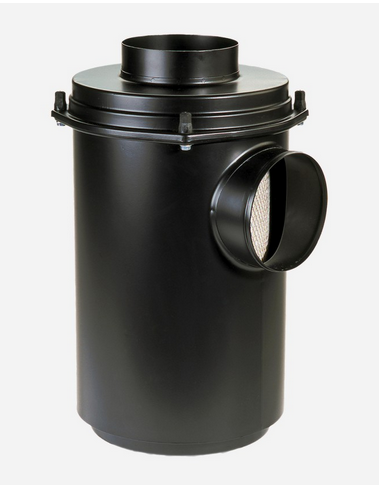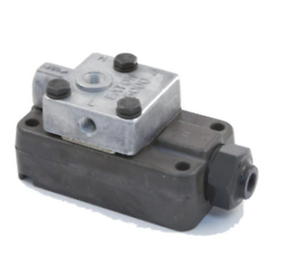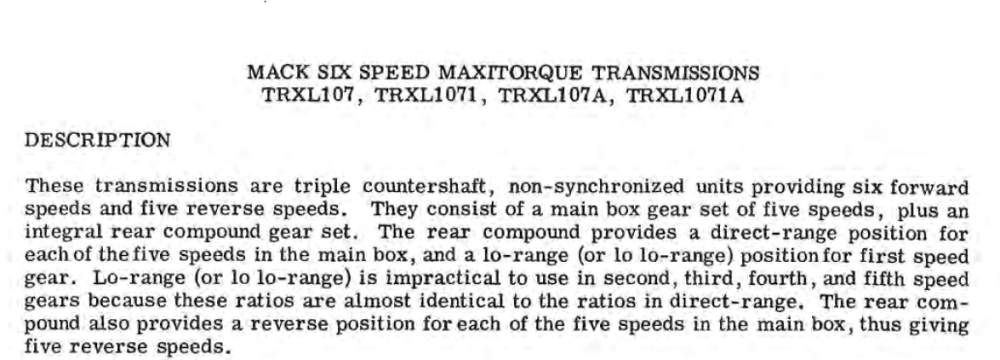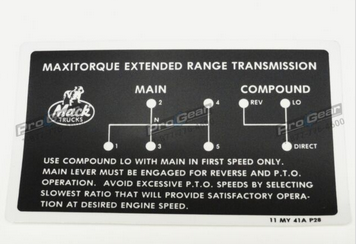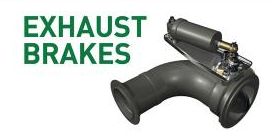-
Posts
2,624 -
Joined
-
Last visited
-
Days Won
37
Content Type
Profiles
Forums
Gallery
Events
Blogs
BMT Wiki
Collections
Store
Everything posted by doubleclutchinweasel
-
For what it's worth, I love the tall pipe on top of the canister. Lots of our R600s had that (like the one in my profile pic). Think it was pretty common on the Thermodyne engines (like my R611). They were originally oil-bath cleaners. Mine still was. Most of the ones we had back then had been converted to a replaceable paper element. It was a Mack kit they used to sell. When I had mine, I tried with no luck to find that old kit. Would have loved to have replaced mine. When we got our first Maxidyne truck, it had the short pipe on top. Little squatty thing. Not sure if that was a Maxi/Thermo difference, or if it just happened to be the right year model. Or, maybe it was a paper filter setup already. Do not remember. But, I do remember the one I spent most of my time in having the "oil bath" canister, but with the paper filter inside it. Was kind of a nice surprise the first time I pulled the bottom off of it and DIDN'T get oil all over me! I have also seen many a Mack with a plain black aftermarket canister on them. I think it's a Donaldson item. Looked something like this. Maybe you can adapt something like that.
-
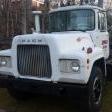
1964 C-609 LST (C-600) for sale on Facebook Marketplace
doubleclutchinweasel replied to Milaca's topic in Trucks for Sale
Story of my life: a day late and a dollar short! -
Correct. The "later" ones are the ones I was more familiar with, where the REV was in the compound box. I don't think I ever saw the "early" one in person.
-

Parts is Parts
doubleclutchinweasel replied to teched's topic in Antique and Classic Mack Trucks General Discussion
Hopefully, you will find a "direct in 4th" setup, which gives you double-overdrive. Makes for a very long-legged puppy. I'll be watching this one closely! You've got me interested! -

Parts is Parts
doubleclutchinweasel replied to teched's topic in Antique and Classic Mack Trucks General Discussion
Is the shift plate still in the cab? -
IF that's the original transmission and IF that's the original plate, and IF the plate is correct, and IF there was an overdrive in there, the plate would lead one to believe the overdrive was in the main box and the auxiliary was direct. Of course, I would still spin the main box to be sure. That's really the only way to tell for sure. See if the output shaft turns the same as the input in 4th or 5th. Anyway, I hope you get it sorted out. It's a real pain to give up highway speed. By the way, I have a friend who, years ago, swapped out a 9-speed Unishift for a "split 5" Fuller in a B61. He thought it was a 10-speed with overdrive, but it did not have a hi and lo range...just a lo and dir splitter on a 5-speed box. Wanted more speed. I tried to tell him his 9-speed was an overdrive box, and his Fuller was either a direct or would have roughly the same overdrive as what he had. He was convinced the Unishift was a direct. He was very unhappy after he went to all the trouble to put the Fuller in, only to find out it was a direct model...just like it said on the splitter (lo & dir)! Lost at least 5 MPH. Could have saved all that hassle just by shifting it and spinning the shafts, all while it was laying on the ground! What he ended up with was essentially the same thing as his Unishift, without the overdrive. Sorry. Kinda went off on a tangent there! That's neither here nor there. Just kind of a humorous story. Anyway, good luck getting it sorted out, and let us know what you figure out.
-
My RT-915 had the same problem. I usually had to flip it lo-hi several times before it would work the first time. After that, it was fine for the rest of the day. I think mine ended up being a combination of an air compressor bypassing a little oil and the "slave valve" on the transmission. Of course, the old model had been discontinued, and I had to adapt the newer model to it. Looked something like this.
-
Seems like I have seen the "reverse the arm" thing done before. If you can work in a cable setup, like 63BMack is talking about, I think you'll be very happy with the results. My '70 R had the cable setup on the pull clutch, and it was the easiest clutch I ever drove or adjusted. Be interested to see what you come up with.
-
Welcome to the Dog Pound, John. I think you'll enjoy it here.
-
I'm kind of a Quad-freak! I grew up on the 18-speed double-overdrive Quadruplex. Have driven the 13-speed Triplex version. Same, without the LO-LO gears. Love those 2 boxes. Once you learn them, there truly is a gear for all occasions. Had 2-3 different shifting sequences, depending on the load and grade. Even developed a couple of different split-shifting styles. Again, depended on how big of a hurry you were in. To me, a Mack needs 2 sticks. The 15 RoadRanger I had in my '70 was a much more user-friendly box. But, I always felt a little bad that it didn't have the Quad in it. I hope to have another one someday.
-

B-73 Restoration
doubleclutchinweasel replied to mattb73lt's topic in Antique and Classic Mack Trucks General Discussion
Sexy as socks on a rooster... -
Here is some info about the later models, with REV on the compound stick. But, I can't find anything on the OD versions (1070). So, I don't know if they ever did one with OD AND REV both in the compound case. But, it seems possible. Again, the shift map plate would probably tell if it was a lo-hole or and OD setup. Here is the plate (off eBay) for a lo-hole model.
-
Here is some interesting info. Apparently, there WAS a setup with OD in the rear box. If this is the trans you have, then the OD on the compound stick can only be engaged when the main is in 5th. But, I don't know if these had REV on the compound. Doesn't sound like it. I am going to dig more into the "late" production boxes, and see what they have. Learn something new every day...
-

B-73 Restoration
doubleclutchinweasel replied to mattb73lt's topic in Antique and Classic Mack Trucks General Discussion
I love the look of that setup. Gotta have the Mack caps on them! -

B-73 Restoration
doubleclutchinweasel replied to mattb73lt's topic in Antique and Classic Mack Trucks General Discussion
Couldn't zoom in far enough. Are those wheels stud- or hub-piloted? It's looking great! -
Checking the front box in/out ratio would still be helpful. This would tell for sure if the front box had an overdrive gear in it. Some of these guys know a lot more than I do, but all the 2-stick Maxitorque auxiliary boxes I (personally) ever saw had a "lo" and a "dir". Never saw one with an OD in the auxiliary. I would suspect that there is only one set of reduction gears in the auxiliary (for lo), and the "dir" is just locked shaft-to-shaft. And, of course, the reverse set would be in there. If the aux is "dir", the sliding dog clutches would just key the shafts together. If there is an OD in there, then I would suspect the "lo" would be locked shaft-to-shaft, and the "od" would engage the overdrive gears. What did it say on the shift plate? LO and DIR? Or DIR and OD?
-

Exhaust Part???
doubleclutchinweasel replied to msbulldog601's topic in Modern Mack Truck General Discussion
-
Some tire manufacturers recommend a little less air pressure when running duals. This is because, due to uneven wear or the shape of the road, one tire can wind up with more weight on it than the other. Having a little less air pressure in them allows for some natural compensation between the two tires. This is also why the weight rating on a set of duals is sometimes (always?) a little less than double that of a single. At least that is how one of the big tire manufacturer's engineers explained it to me. Even the original door stickers on the older trucks called for a little less air in the duals than in the steers. You made get varying opinions on this.
-

Back in a Mack G
doubleclutchinweasel replied to D2Denny's topic in Antique and Classic Mack Trucks General Discussion
Nice pair.
BigMackTrucks.com
BigMackTrucks.com is a support forum for antique, classic and modern Mack Trucks! The forum is owned and maintained by Watt's Truck Center, Inc. an independent, full service Mack dealer. The forums are not affiliated with Mack Trucks, Inc.
Our Vendors and Advertisers
Thank you for your support!



